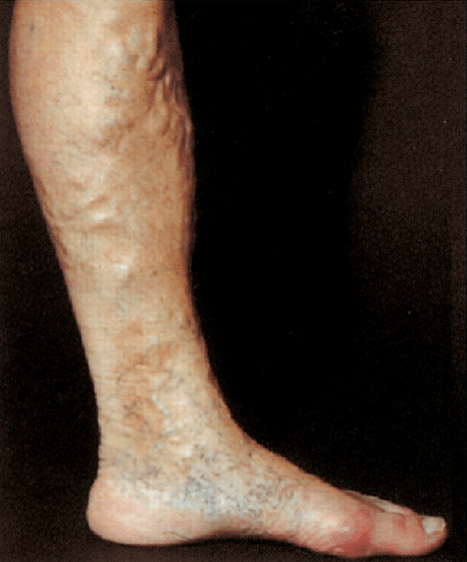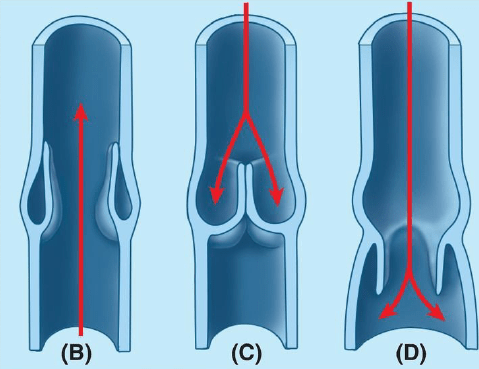Varicose Veins
content of this page
1- Introduction
2- Anatomical Overview
3- Causes
4- Treatment
Introduction
Varicose veins are enlarged, swollen, and twisted veins that often appear blue or dark purple. They most commonly occur in the legs and feet due to the increased pressure on the veins from standing and walking upright.
These veins may be a cosmetic concern for some, but they can also cause discomfort, pain, and itching. In severe cases, they can lead to more serious problems such as ulcers or blood clots

Anatomical Overview
When the walls of veins lose their elasticity, they become weak. A weakened vein dilates under the pressure of supporting a column of blood against gravity.This results in varicose veins—abnormally swollen, twisted veins—most often seen in the legs. Varicose veins have a caliber greater than normal, and their valve cusps do not meet or have been destroyed by inflammation. Varicose veins have incompetent valves; thus, the column of blood ascending toward the heart is unbroken, placing increased pressure on the weakened walls, further exacerbating the varicosity problem. Varicose veins also occur in the presence of degenerated deep fascia. Incompetent fascia is incapable of containing the expansion of contracting muscles; thus, the (musculofascial) musculovenous pump is ineffective.
Frequently, the great saphenous vein and its tributaries become varicose (dilated so that the cusps of their valves do not close). Varicose veins are common in the posteromedial parts of the lower limb and may cause discomfort. In a healthy vein, the valves allow blood to flow toward the heart (B) while keeping blood from flowing away from the heart (C). Valves in varicose veins (D) are incompetent due to dilation or rotation and no longer function properly. As a result, blood flows inferiorly in the veins, producing varicose veins.

Causes
Weak or Damaged Valves: Veins have one-way valves that help blood flow toward the heart. If these valves weaken or are damaged, blood can flow backward and pool in the vein, leading to varicose veins.
Increased Pressure in the Veins: Anything that puts pressure on the veins can contribute to varicose veins. This includes standing or sitting for long periods, obesity, pregnancy, and constipation (which can increase abdominal pressure).
Age: As people age, the veins can lose elasticity, causing them to stretch and weaken, which can lead to varicose veins.
Family History: If other family members have had varicose veins, you may be more likely to develop them.
Gender: Women are more likely to develop varicose veins than men, possibly due to hormonal changes during puberty, pregnancy, and menopause.
Pregnancy: Pregnancy increases the volume of blood in the body and puts added pressure on the veins, which can lead to varicose veins.
Obesity: Excess weight can put pressure on the veins and lead to varicose veins.
Lack of Movement: Sitting or standing for long periods can affect blood circulation and contribute to varicose veins.
Sun Exposure: Prolonged sun exposure can cause the skin to lose its elasticity, making varicose veins more noticeable.
Treatment
Lifestyle Changes: These include regular exercise, maintaining a healthy weight, elevating the legs when resting, and avoiding long periods of standing or sitting.
Compression Stockings: These special stockings apply pressure to the legs, helping to improve blood flow and reduce swelling and discomfort.
Sclerotherapy: This involves injecting a solution into the varicose veins, which causes them to collapse and fade away over time.
Laser Therapy: A laser is used to close off smaller varicose veins.
Radiofrequency Ablation: A small catheter is inserted into the vein, and radiofrequency energy is used to heat and seal the vein closed.
Vein Stripping: This surgical procedure involves removing the affected vein through small incisions.
Ambulatory Phlebectomy: This involves removing smaller varicose veins through tiny skin punctures.
Endoscopic Vein Surgery: A thin tube with a camera is inserted into the vein to close it off.
Laser Therapy: A laser is used to close off smaller varicose veins.
High Ligation and Vein Stripping: This involves tying off the vein before it joins a deep vein and removing the vein through small incisions